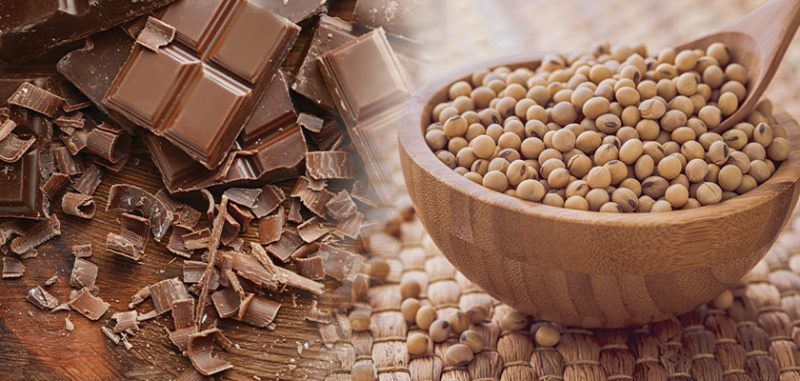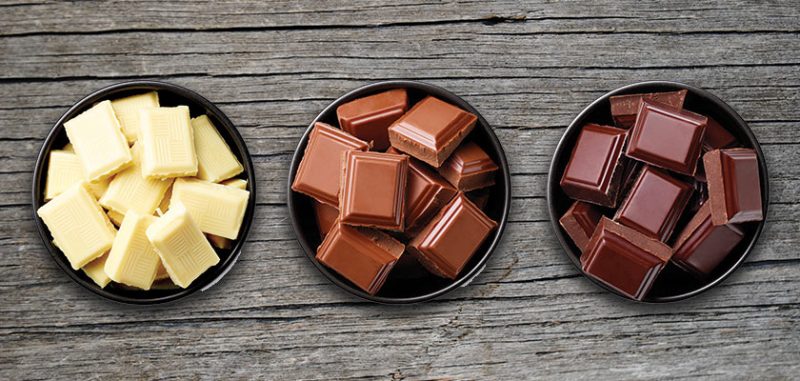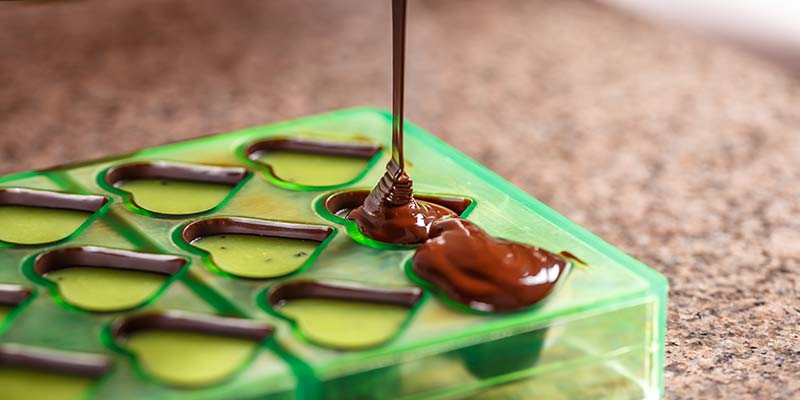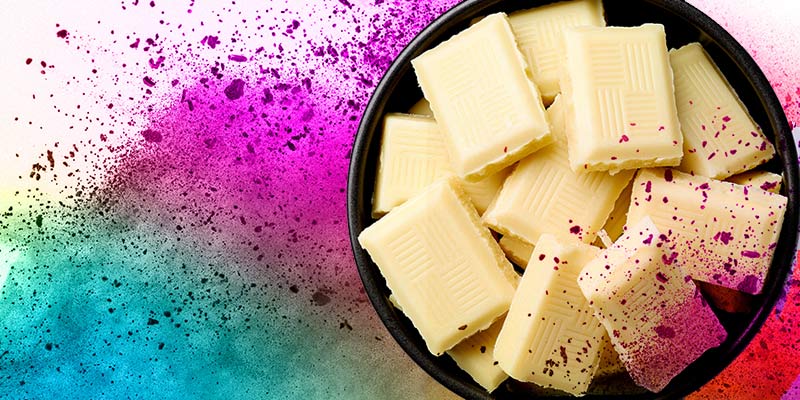When inspecting the ingredients of commercially manufactured chocolate, soy lecithin is a common recurring ingredient. But what does soy lecithin in chocolate do, and why is it there? In this article, chocolate expert Simon Knott discusses the role of soy lecithin.
Soy lecithin chocolate recipes have been used consistently by manufacturers since the 1930s. The improved workability of the chocolate and the considerable cost savings over cocoa butter have made them a winning combination.
Soy lecithin was first identified in 1845 by a French pharmacist, Théodore Gobley, who later in the same century gave it its chemical name phosphatidylcholine. Lecithin comes from the Greek, lekithos for yolk, from which it was first derived. Gobley discovered it occurs naturally in human organs, such as the lungs and brain as well as numerous plants, and animals.
Most lecithin is still derived from soybeans, however, as soya is a major allergen, sunflower lecithin is starting to take its place. Lecithin is an emulsifier and food additive, which is used in numerous food products, which need stabilising. It’s possible to find soy lecithin in chocolate, baked goods, dressings etc.
The role of soy lecithin in chocolate
Soy lecithin is used in chocolate as an emulsifier.
With a high fat content, it’s no surprise that lecithin isn’t very soluble in water. However, it is an excellent emulsifier, which means it can reduce the tension between molecules of fat and water in a mixed solution.
Fat and water molecules don’t naturally mix because the bonds holding the molecules together don’t permit any attraction. However, when lecithin is added to the fat and water solution the size of the fat droplets reduces so much that the solution becomes an emulsion.
This means that the tiny droplets of oil suspended in the liquid appear as a uniform mixture and the oil droplets won’t clump and revert to large ones.
How does soy lecithin emulsify chocolate?
Chocolate is a suspension of tiny particles of cocoa solids, cocoa butter, sugar, lecithin, and sometimes milk. The solid particles are distributed throughout the cocoa butter, so that when it is heated it melts and flows smoothly.
Lecithin is added to uniformly bind together each of these ingredients, creating the chocolate with the smooth melt-in-the-mouth texture we all love.
Benefits of using soy lecithin in chocolate
Lecithin is a crucial ingredient in chocolate for several reasons:
Easier Tempering
Working with chocolate when it is less viscous is easier. Adding lecithin to reduce the chocolate viscosity makes it much more workable, so blending it with seed chocolate to temper also becomes more straightforward.
Improved Viscosity and Flow
In commercial manufacturing, it is vital chocolate has the optimum viscosity and ability to flow when melted. This can be controlled by varying the cocoa butter and lecithin content.
However, cocoa butter is a more expensive ingredient and so lecithin is used preferentially as more cost-effective. Lecithin also has a secondary effect in that it reduces the friction between the cocoa solid particles, which helps to lower the viscosity of the chocolate as well.
Extended shelf life
Chocolate has both a high sugar content and a negligible water content, creating a longer shelf life. However, if a stable product isn’t created, fat molecules will migrate to the chocolate surface forming a white ‘bloom’ of tiny particles. Although safe to eat it spoils the appearance of chocolate and most customers won’t buy it.
Using lecithin in production helps to bind the cocoa butter molecules along with the other component ingredients. This locks the cocoa butter molecules in place, leaving them unable to migrate to the surface.
How is soy lecithin manufactured?
Lecithin is a mixture of several fatty compounds, the most important of which are choline and cephalin. Combined, these fats enable emulsions of oil and water to form. Choline is naturally better at emulsifying a small quantity of oil in a large quantity of water, and vice versa for cephalin.
Lecithin is derived from soybeans, which are part of the legume family along with peas, beans, and peanuts. The processing starts by drying and hulling soybeans before lightly baking them (60-88° C) and crushing them into flakes.
The flakes are then mixed with hexane solvents, which extract the soy lecithin. The hexane is boiled off leaving the pure soy lecithin. The lecithin destined for the food industry is finally treated with hydrogen peroxide to lighten its colour.
After processing, the remaining protein in soy lecithin is very small and so even those who are allergic to soy should be safe to eat it. However, for safety’s sake, lecithin is still classed as a major allergen and needs to be labelled clearly as such.
If you decide to use soy lecithin in your own chocolate-making, make sure you correctly declare it as an ingredient and allergen on your packaging.
Sources:
Soy Info Center: https://www.soyinfocenter.com/HSS/lecithin1.php
National Lecithin: https://nationallecithin.com/2021/07/sunflower-lecithin-vs-soy-lecithin-whats-the-difference/








